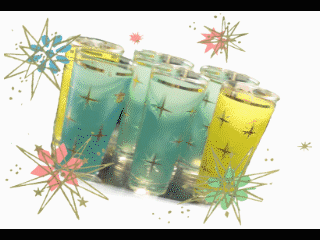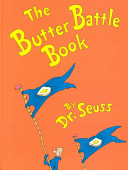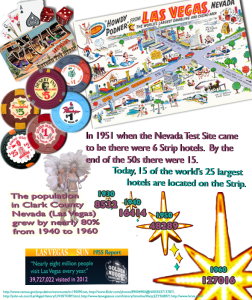Atomic Vegas: An Era of Influence
By Monique Gaudin
On January 27, 1951, the first of many atomic blasts conducted sixty-five miles northwest of the city of Las Vegas, Nevada, changed the course of the small desert community, and consequently defined an era.
Many equate the dropping of the atomic bombs on Japan as the official launch of the atomic era, yet the 1,024 atomic tests conducted at the test site, more importantly the 100 atmospheric tests which took place from 1951 until the 1963 treaty moving testing underground until the moratorium in 1992, created a marketing phenomenon impacting all facets of everyday life.
There were roughly 100 songs with atomic themes or ties in between 1945-1966. Here is a montage of a few from www.bopping.org/atom-uranium-and-hillbilly/ Sound Editing: Monique Gaudin
In today’s society, the endorsement of the atomic bomb on everything from cereal to toys would be hard to fathom. But in the 50s and 60s, the atomic symbol stood for progress – the vision of a nation living in a new age of peace, prosperity and a future. The technology infused pop culture of “tomorrow,” was not only the expression of a generation, but the standard bearer of what was to come.

“As Americans came to terms with the reality of atomic energy in the decades after Trinity, Hiroshima, and Nagasaki, their fears, hopes, and concerns found expression not only in governmental debates and media editorials but also in a growing atomic culture,” surmised Scott C. Zeman and Michael A. Amundson, the editors of Atomic Culture: How We Learned to Stop Worrying and Love the Bomb.
“By taking a frightening phenomenon and making it familiar, acceptable, non-threatening, beautiful, and in some cases even desirable, the mushroom cloud ingrained itself in the American psyche. Much like whistling in the dark, it helped us to be unafraid and it shored up our confidence during those uncertain times,” shares A. Costandina Titus in her essay, The Mushroom Cloud as Kitsch.
“I don’t think it was ignorance, I think maybe it was an innocence of sorts. We’d come through a very terrible war and people were solidly behind the country. They were very patriotic. They really believed in the American way of life and now that it had survived the challenge, I think that was just reinforced,” says Allan Palmer, Executive Director and CEO of the National Atomic Testing Museum.
Atomic testing was seen then as salvation. A governmental security blanket in which idyllic post war America could assure freedom and the American way of life.
The atomic age gave Las Vegans a patriotic purpose for the greater good of the nation and helped market the atomic lifestyle. Testing provided a diverse perspective of the oasis in the desert.
People of the time, thought that the city was a den of iniquity, a town of drunks, gamblers and divorcees. “Las Vegas, which in so many ways, is considered the least decent, least respectable American city” says CSN Professor of History Michael Green, “and about 60 miles northwest of us we’ve got some atomic bombs going off, and that proves we are American and as decent as anybody else.”
While Las Vegans did their part in keeping America safe, working at the test site or in town, they believed they were part of a bigger mission to preserve national security. “It has been a great experience and I’ve enjoyed every minute of it. I’d do it again tomorrow,” says Ernest Williams, a veteran of the Korean War, and thirty-seven plus years spent employed within nuclear testing.
From 1951-1962, during the years of atmospheric atomic testing, viewing parties would be held for casino clientele on the roof tops downtown Las Vegas. Interactive eLearning element: Monique Gaudin
Mr. William’s pride is a commonly shared opinion by the locals who were part of the blossoming city of the 1950’s. Testing not only brought what protestors of the 70s and 80s deemed as death and destruction, but technology, innovation, higher education, and a multicultural population of people creating a new way of living. Developing a trend of ongoing reinvention is still embedded into the lifestyle of the city today.

Jack LeVine, a Las Vegas Realtor, who caters exclusively to clients seeking homes of that period, empathizes that it is not just the Baby Boomers looking to recapture the security of their childhood, but the twenty-thirty something crowds who grew up in “life-less suburbia,” trying to connect to a community, and find artistic expression in the character of the era.
Today’s resurgence of “Vintage Vegas” in the shadow of recessionary decline, nuclear waste debates, and international testing, is a retro lifestyle reprisal from the twenty-first century stress and worry, to a refuge of a happier time.
Bruce “Smiley” Woodbury, a local retailer and tiki enthusiast of the sub-cultures of the 1950s, thinks the popularity of atomic lifestyle is a whitewashed concept. “We have a sort of Disney version in some ways with alcohol of the 50s atomic era. Putting the nastiness aside, we just like to have fun.”
Admitting a plain and simple “like of the look and appeal” of that bygone time, Mr. Woodbury also credits the regression to the trending culture of the day, to the current economic times, where many are taking pay cuts or are without work all together; consoling that returning to a place of innocence and exploration provides solace from reality.

When looking at what Professor Michael Green, states as the “long decade of the 50s,” which includes up to the assassination of President Kennedy. Marking what he states, “many consider the true loss of American innocence,” the timeline coincides with atmospheric testing at the Nevada Test Site, now named, the Nevada National Security Site.
The societal embracement of the atom as a life style is part and parcel of the age of; I Love Lucy, Leave It to Beaver, and the current hit, Mad Men, along with the recent canceled shows, Pan Am and the Playboy Club.
While television’s Perry Mason was exploring social reason, Alfred Hitchcock was probing the dark side of life, with “what ifs,” and Star Trek was forging a “new frontier.” Las Vegas was setting the stage of Rat Pack cool and atomic design, in a Googie mid-century modern house of the Jetsonian future.
The complexity of the relationship of the “cloud” as coined by Titus, transitioned with the realization of its impact from popularity, through protest, to the now nostalgic kitsch representation.
The big housing boom of the 90s, moving into the early 2000s, tripled the population and added a new type of explosion to Las Vegas, the mega-resort boom. But as Dr. Green professes, “You can compare as many decades as you want, or as many eras as you want, but the 50s with the test site, with the building of so many strip hotels, with the influx of population, really does a lot to set up what comes afterwards.”
Arguably, atomic testing is a hot topic in contesting its devastating effects on both humans and the environment. It’s accompanied by the ongoing political debates of world peace and national security. But setting aside the more ominous by-product of technological advancement in light of the time period, the national mindset, the place and the impact, the bomb that in so many ways built Las Vegas, has an enduring association with a time of peace and levity.
Scroll over George Nelson atomic clock to see more information and fun facts on the nuclear era. Interactive eLearning element: Monique Gaudin
The “pins” on My Atomic Board show everything from resources used in compiling this page, to some great Department of Defense declassified videos.
Follow Monique’s board My Atomic Board on Pinterest.
Visit Atomic Then & Now board on Scoop.it to access a wide variety of current and past resources on nuclear testing.
Additional websites to explore on the topic:
Nevada Test Site Oral History Project, National Nuclear Security Administration, National Security Technologies, CTBTO, Arms Control, UN, Bopping, Atomic Platters, Johnston Archive, Trinity Atomic Website, Los Alamos National Laboratory Research Library, Atomic Archive, The Big Below, Archive.org,
Well done Monique! Congratulations. Nicely laid out with good information.
Monique, this website is sensational, very well done, great use of multimedia.
Thanks Kathleen an Jeff. Glad you liked it. The next one will be on the Kefauver hearings 🙂 Vegas is far from lacking in stories to tell.